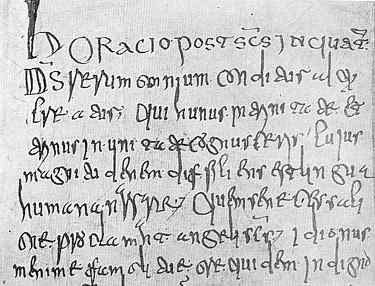 |
| This is the first half of the text. At first glance you may be alarmed that there is not a single word that you can recognise, apart from Horacio in what might be described as a grotty uncial script in the top line. So who is Horacio? Some obscure saint perhaps? No, he is a spelling anomaly for the word oratio. The letter h was sometimes added to words that begin with a vowel in medieval spelling, and there is another example in the third line, with hunus written for unus. The letters t and c were often used interchangeably for the sh sound in words that normally use t in modern Latin spelling. The letters i and e seem to be interchanged in somewhat random fashion in some letters of this passage. Then there are the ligatures. You may need to go back to the script sample to untangle the forms of many of these, as they are not very intuitive. Add to this that the letter spacing is a bit odd, and you do have a difficult little sample to read. (I can't really read it. I cheated.) What is interesting about the spacing is that words that contain ligatures are sometimes broken up awkwardly, as if the scribe was concentrating on doing the ligatures to the detriment of the word spacing as a whole. Look at the word creatur at the beginning of the third line, or trinitate as the second last word of the same line, or the word magnitudenem at the beginning of the fifth line. Well, I have already suggested that he may have been a scribe in training. |
|
| Gallican Missal, 8th century (Vatican Library, Regin. 317, f.136v) |
|
|
overview | text
| alphabet | abbreviations
| exercises | transcript
| translation
| |
|
Click
on each of the above to walk your way through the text. The transcript
will appear in a separate window so that you can use it for reference
at any time. These exercises are designed to guide you through the text,
not test you, so you can cheat as much as you like. |
|
|
 Script sample for this example Script sample for this example |
 Index
of Exercises Index
of Exercises |
 Index
of Scripts Index
of Scripts |
|
 |